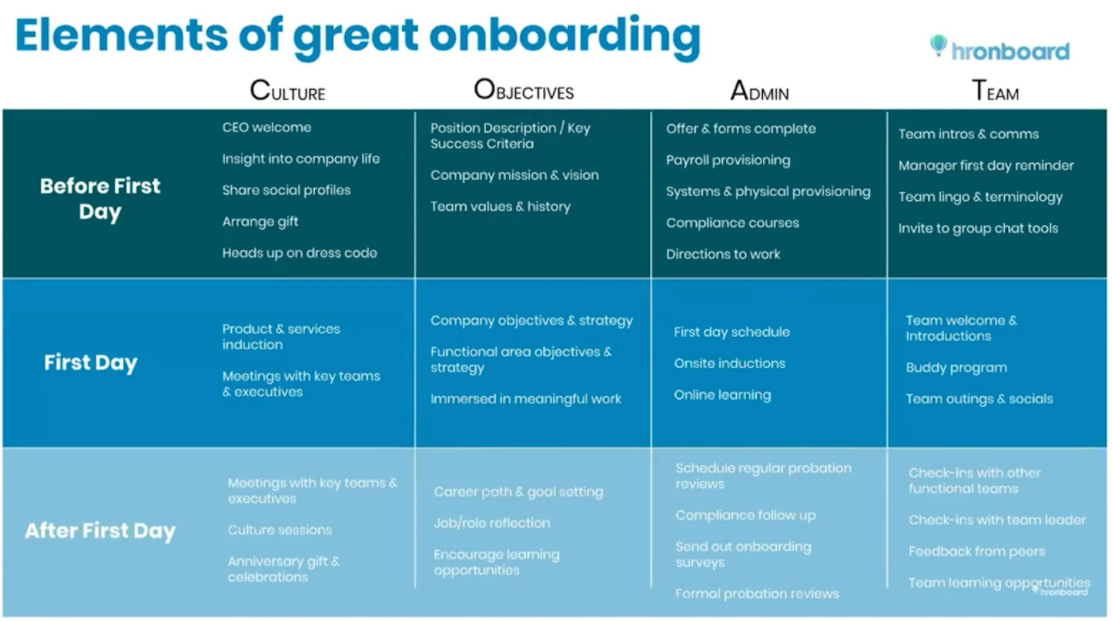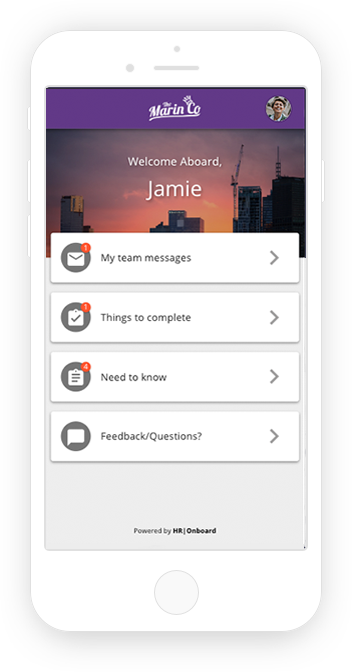For years, employee onboarding has been centred around transactional activities, namely ensuring all forms and paperwork are completed on time and appropriately filed. However, expectations have since shifted – the priority now is to provide new starters with the best post-offer experience possible. The issue is that onboarding can be overwhelming. With so many components at play, it can seem complicated to a new starter and may cause burnout.
To make sure onboarding helps rather than harms the new starter experience, we have mapped out the onboarding journey for you, so you are delivering the right content at the right time. We will also highlight how HROnboard’s Induction solution can help you take your onboarding from zero to hero.
Key elements to a successful onboarding journey
When planning the delivery of your onboarding experience, you’ll quickly find there is a large amount of information to convey. Whilst important, not all information must be provided in one go – it can span across days, weeks or even months if relevant.
No matter your business industry, size or employment type, there are core elements that make up an awesome onboarding journey. At HROnboard we call these critical ingredients ‘COAT’, which stands for:
Culture: Presenting company values, vision and culture.
Objectives: Ensuring new starters know the expectations of their role.
Administration: Completing fundamental administrative tasks e.g. paperwork and provisioning.
Team: Integrating new hires into the team and introducing them to their peers
So, what exactly goes into an onboarding journey, and why?
To help visualise how these elements interact during onboarding, the first step is to create an onboarding map. It’s handy to break this down into three main timeframes: before the first day, on the first day and after the first day. We break these down below using the COAT acronym – see below.

Three components that should not be forgotten after a new starter’s first day include:
- Surveys: When rolling out a new onboarding experience, it’s imperative to seek feedback. Surveys are a great tool to gauge employee sentiment and uncover potential areas for improvement.
- Probation management: Probation check-ins (whether monthly, quarterly or bi-annually) are important for measuring how well a new starter is settling into their role. To ensure this activity is completed on time, send reminders to team leaders to schedule reviews.
- Employee referral campaign: If your company has an employee referral program, information about it can be drip-fed later in the onboarding journey (e.g. one or two months after the first day).
How HROnboard can help revolutionise the onboarding experience
Traditional, admin-heavy onboarding is more likely to create information overload for new starters, so taking a digital approach can revolutionise the experience.
There are certain details that make or break a great onboarding experience – the most important being personalisation. HROnboard’s built-in induction templates enable teams to personalise every interaction. This approach to onboarding lays the foundations for a truly unique experience.
By using tech to increase personalisation, you can move beyond the basics of onboarding and communicate paper-based information in a creative and engaging way.
Below are some tips for creating effective onboarding journeys.
1. Personalise
With HROnboard’s journey templates, you can fully customise and personalise each employees’ onboarding journey, right down to the day information is delivered.
2. Start with the basics and continually imporve
It’s important to not get bogged down in getting your onboarding journey perfect straight away. Consider default content and ‘activity cards’ in your templates that cover the essential components and use these to frame the onboarding journey, and then evolve from there.
3. Bite-sized & drip-fed
Break down your onboarding program into bite-sized pieces and consider which pieces are best to share and when. It is important to be sensitive to your new starters and be careful not to overwhelm them, which is why drip-feeing micro content is more productive and helps to increase information retention
4. Use journey templates
Start with our recommend onboarding content and activity cards, then layer your own content on top. This way, you’ll know you have the essentials covered and can then get add your company’s unique stamp.
The importance of the team leader
How to keep team leaders engaged is a hot topic in HR. Their input is important to create an effective employee journey. Here are some ways in which you can keep team leaders ‘in the loop’ and engaged with the new starters journey.
1. Give them a helpful nudge
You can help team leaders become epic managers by automating some handy prompts and reminders. Assigning key tasks and deadlines to team leaders can act as a gentle ‘nudge’.
2. Creating an epic team welcome
Another way to cultivate team leader engagement is to advise them to leave a ‘welcome message’ for the new starter. This is a nice personal touch that can make all the difference to an apprehensive new employee.
Top tips for mapping your employee journey:
So, to summarise what we’ve talked about…
- Take an iterative approach, then keep improving
- Start with essentials and continually improve
- Break down complex ideas into digestible bite-sized pieces
- Test and measure effectiveness
- Avoid information overload
- Map out content and get ideas from other teams and team leaders
- Group content into bursts and avoid data overload
- Get feedback from recent new starters
- Transition to an onboarding tool
- Utilise personalisation features, e.g. job, location
- Utilise notifications and nudges to improve the overall experience for all involved
Onboarding is a crucial organisational activity, but getting it right requires some planning. With our tips and tricks, your new starters will have a positive post-offer experience and become valued team members.
HROnboard, an ELMO company, offers a best-in-class software solution that reduces the amount of time HR teams and leaders spend securing the best candidates and undertaking the critical onboarding process for new hires. Our solution also helps manage internal employee role changes and can create a smooth and seamless process for exiting employees. To find out more, reach us here.
ELMO Cloud HR & Payroll offers end-to-end solutions for the entire employee lifecycle, from ‘hire to retire’. This includes recruitment, learning, performance management, payroll, rostering / time & attendance, and more. For further information, contact us.

Want to know what it’s like to get hired through HROnboard?
Enter your details and we’ll send you a new hire welcome direct to your phone
